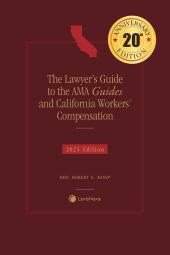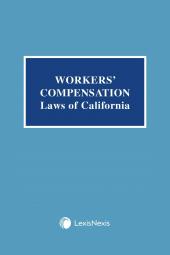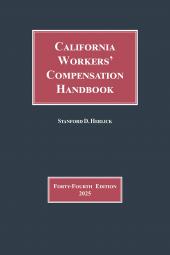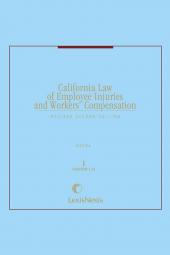The Lawyer's Guide to the AMA Guides and California Workers' Compensation
Select a format
 International Order Inquiry
International Order Inquiry
Select subscription type
Terms & conditions
Subscribers receive the product(s) listed on the Order Form and any Updates made available during the annual subscription period. Shipping and handling fees are not included in the annual price.
Subscribers are advised of the number of Updates that were made to the particular publication the prior year. The number of Updates may vary due to developments in the law and other publishing issues, but subscribers may use this as a rough estimate of future shipments. Subscribers may call Customer Support at 800-833-9844 for additional information.
Subscribers may cancel this subscription by: calling Customer Support at 800-833-9844; emailing customer.support@lexisnexis.com; or returning the invoice marked "CANCEL".
If subscribers cancel within 30 days after the product is ordered or received and return the product at their expense, then they will receive a full credit of the price for the annual subscription.
If subscribers cancel between 31 and 60 days after the invoice date and return the product at their expense, then they will receive a 5/6th credit of the price for the annual subscription. No credit will be given for cancellations more than 60 days after the invoice date. To receive any credit, subscriber must return all product(s) shipped during the year at their expense within the applicable cancellation period listed above.
The total price includes the product(s) listed in the Order Form and any Updates for a limited period (minimum period of 30 days) after the order is placed ("Order Window"). Shipping and handling fees are not included in the grand total price.
All shipments may be returned, at subscribers' expense, for full credit of the Price within 30 days of receipt.
Shipments may not be returned, and no credits will be issued, more than 30 days after receipt.
After the Order Window, subscribers will receive notice of Updates along with the then-current grand total price and order process as Updates become available. Subscribers will only be shipped those Updates they specifically request.
Product description
View a sample of this title using the ReadNow feature
Senate Bill 863 (SB 863) and Senate Bill 899 (SB 899) have taken the California workers' compensation industry by storm, revolutionizing the way permanent disability is determined along with changes in apportionment of disability. Now that the 5th Edition of the AMA Guides to the Evaluation of Permanent Impairment is the gold standard as the first step to determine permanent disability in California, the claims, legal, and judicial participants in the workers' compensation system need their own guidance on the use of the AMA Guides in these cases. The Lawyer's Guide to the AMA Guides and California Workers' Compensation, by Robert G. Rassp, is the only practical guide to help you calculate and understand permanent disability ratings under SB 899 and the AMA Guides.
Workers' compensation claims involving the AMA Guides will emerge that hinge on the proper use, misuse, or under-use of the Guides and on the causation of permanent disability under the apportionment statutes and developing case law. The Lawyer's Guide to the AMA Guides and California Workers' Compensation will assist you in the proper use of the AMA Guides and thus enable you to determine whether a medical report constitutes substantial evidence. In addition, there are some observations about the AMA Guides that are intended to assist you in learning and understanding them and to help you formulate questions to doctors about them.
The Lawyer's Guide to the AMA Guides and California Workers' Compensation is organized as follows:
• Chapter 1 contains definitions of common terms and a list of acronyms along with explanatory material, as well as a list of common medical conditions by AMA Guides chapter.
• Chapter 2 covers the effects of SB 899 and SB 863 reform legislation and the application of the AMA Guides to California workers' compensation cases. This chapter teaches you how to do a rating string under the 2005 PDRS and 2013 PDRS.
• Chapter 3 is a chapter-by-chapter analysis of the AMA Guides.
• Chapter 4 contains examples of AMA compliant and non-AMA compliant medical reports and a discussion about developing the record to establish accurate WPI ratings under the AMA Guides 5th Edition.
• Chapter 5 provides a summary of how SB 863 affects your law practice, including changes in the law that affect permanent disability payments, supplemental job displacement benefits and the Return To Work fund. Some examples of how to rate specific types of injuries are included.
• Chapter 6 contains summaries of cases and WCAB panel decisions relating to the AMA Guides, the 2005 PDRS, and apportionment, along with expert commentary.
• Chapter 7 provides a framework for discovery in cases that involve the AMA Guides and covers medical-legal issues related to rebutting a strict impairment rating under the AMA Guides 5th edition.
• Chapter 8 provides medical information every lawyer and judge should know about specific parts and regions of the body we commonly see in our cases.
• Chapter 9 provides a detailed discussion of psychiatric injuries—how they are now diagnosed under the DSM-5, how and when they can be rated for permanent impairment, possible alternative rating methods not using the GAF scale, and apportionment issues.
• Appendix A contains the 2005 PDRS, which is reprinted in full for your convenience. Note: Until the Administrative Director adopts an official 2013 PDRS, SB 863 mandates reference to the adjustments for occupation and age in the 2005 PDRS.
• Appendix C updated "money charts" (permanent disability rates) for quick reference. We thank Jay Shergill, Esq. for allowing us to reprint his latest tables in our publication.
• The Index is organized by topic and helps you quickly find what you need in this guidebook.
The previous edition's ISBN is 9781663369963.
eBooks, CDs, downloadable content, and software purchases are noncancelable, nonrefundable and nonreturnable. Click here for more information about LexisNexis eBooks. The eBook versions of this title may feature links to Lexis+® for further legal research options. A valid subscription to Lexis+® is required to access this content.
Table of contents
Ch. 1, How to Use This Guidebook
§ 1.01 Purpose and Organization of This Guidebook
§ 1.02 AMA Guides—Frequently Used Terms
§ 1.03 AMA Guides—Common Acronyms
§ 1.04 AMA Guides—Common Medical Conditions by AMA Guides Chapter
Ch. 2, Permanent Disability Ratings Under SB 899 and SB 863
§ 2.01 The Effects of Reform Legislation
§ 2.02 Overview of Permanent Disability Rating Schedules
§ 2.03 Application of AMA Guides to California Workers' Compensation Cases
§ 2.04 Compliance of Medical Reports With Requirements of AMA Guides
§ 2.05 Pain Adjustments
§ 2.06 Psychiatric Injuries
§ 2.07 Model Joint AME and Panel QME Advocacy Letters
Ch. 3, AMA Guides: Chapter-by-Chapter Analysis
§ 3.01 Introduction
§ 3.02 AMA Guides Chapter 1: Philosophy, Purpose, and Appropriate Use of the Guides
§ 3.03 AMA Guides Chapter 2: Practical Application of the Guides
§ 3.04 AMA Guides Chapter 3: The Cardiovascular System: Heart and Aorta; Chapter 4: The Cardiovascular System: Systemic and Pulmonary Arteries
§ 3.05 AMA Guides Chapter 5: The Respiratory System
§ 3.06 AMA Guides Chapter 6: The Digestive System
§ 3.07 AMA Guides Chapter 7: The Urinary and Reproductive System
§ 3.08 AMA Guides Chapter 8: The Skin
§ 3.09 AMA Guides Chapter 9: The Hematopoietic System
§ 3.10 AMA Guides Chapter 10: The Endocrine System
§ 3.11 AMA Guides Chapter 11: Ear, Nose, Throat, and Related Structures
§ 3.12 AMA Guides Chapter 12: The Visual System
§ 3.13 AMA Guides Chapter 13: The Central and Peripheral Nervous System
§ 3.14 AMA Guides Chapter 14: Mental and Behavioral Disorders
§ 3.15 AMA Guides Chapter 15: The Spine
§ 3.16 AMA Guides Chapter 16: The Upper Extremities
§ 3.17 AMA Guides Chapter 17: The Lower Extremities
§ 3.18 AMA Guides Chapter 18: Pain
§ 3.19 Pain Add-on for Sleep Disorders, Sexual Dysfunction and Psyche as Compensable Consequences of Physical Injuries
Ch. 4, Substantial Medical Evidence and Establishing the Most Accurate WPI Ratings
§ 4.01 Model Sequential Step Analysis
§ 4.02 Substantial Evidence Defined
§ 4.03 AMA Compliant Reports
§ 4.04 The Good, the Bad, and the Ugly: Examples of AMA Compliant and Non-AMA Complaint Medical Reports
§ 4.05 Establishing Accurate WPI Ratings
§ 4.06 Justification for Use of the Guides in Workers' Compensation Cases
§ 4.07 Development of the Record Using AMA Guides Chapters 1 and 2
§ 4.08 Population Averages
§ 4.09 Age or Gender Related Impairments
§ 4.10 Use of Clinical Judgment
§ 4.11 Practical Applications of the Guides
§ 4.12 Measurements Must Be Reliable
§ 4.13 Assistive Devices
§ 4.14 Side Effects of Medication
§ 4.15 Spinal Injury Cases—DRE vs. ROM Methods
§ 4.16 Muscle Strength Deficits
§ 4.17 How to Rate Chronic Pain Syndromes
§ 4.18 Complex Regional Pain Syndrome
§ 4.19 Thoracic Outlet Syndrome
§ 4.20 Failed Lumbar Syndrome
§ 4.21 Rating Chronic Pain in the Absence of Objective Medical Evidence
§ 4.22 Rating Narcotic Addiction and Dependency
§ 4.23 Multiple System Impairments
§ 4.24 Sleep Disorders
§ 4.25 Obstructive Sleep Apnea
§ 4.26 Fibromyalgia
§ 4.27 Pain Add-Ons
§ 4.28 Zero Percent Impairment Ratings
§ 4.29 Headaches
§ 4.30 The Cannon Case: Permanent Objective Medical Diagnosis
Ch. 5, Application of AMA Guides and PDRS, and Effect of SB 863
§ 5.01 Introduction
§ 5.02 Example 1: More Than One Body Part Injured in One Injury
§ 5.03 Example 2: Upper Extremity Injury and Its Sub-Regions
§ 5.04 Example 3: More Than One Body Part Injured in More Than One Injury
§ 5.05 Example 4: Failed Back Case With Psychiatric and Pain Sequelae
§ 5.06 Example 5: Voice/Speech Impairment
§ 5.07 Example 6: Recurrent Disc Herniation
§ 5.08 Example 7: Multiple Upper Extremity Injuries
§ 5.09 Example 8: Spinal Surgery Causes Cauda Equina Syndrome
Ch. 6, Case Summaries With Commentary and Current Issues Affecting Permanent Disability Ratings
§ 6.01 Introduction
§ 6.02 Permanent Disability, Apportionment, and PDRS
§ 6.03 Questions Doctors Ask Us
§ 6.04 Case Law on Permanent Disability Post-2023
§ 6.05 Questions Doctors Ask Us
Ch. 7, Developing the Record and Rebutting the 2005 PDRS
§ 7.01 Overview
§ 7.02 Direct and Cross Examination of Applicants
§ 7.03 Direct and Cross Examination of Physicians
§ 7.04 Medical Questions on Pathology
§ 7.05 Rebutting the 2005 PDRS—Before Almaraz-Guzman and Ogilvie Cases
§ 7.06 Almaraz-Guzman and Ogilvie WCAB En Banc Decisions
§ 7.07 Rebutting a WPI Rating—Post-Almaraz-Guzman III
§ 7.08 Rebutting a Strict Impairment Rating Based on the AMA Guides
§ 7.09 Example #1: Lower Extremity Cases and Table 17-2, The Cross-Usage Chart
§ 7.10 Example #2: Ferras v. United Airlines—Adductor Tendon Tear
§ 7.11 Example #3: Four Objective Findings, But Only One Ratable Impairment—Knee Injury
§ 7.12 Example #4: Rotator Cuff Tears, Shoulder Impingement Cases, Elbows, Any Upper Extremity Joint Involvement
§ 7.13 Example #5: Fractured Elbow With Avascular Necrosis and Contracture
§ 7.14 Example #6: Injured Worker Has Lost Significant Function in One or Both Upper Extremities Due to Multiple Impairments
§ 7.15 Example #7: Carpal Tunnel Syndrome as the Only Diagnosis
§ 7.16 Example #8: Muscle Strength Loss, Loss of Motion and Resection Arthroplasty for Shoulder
§ 7.17 Example #9: Various Ways to Rebut Strict Spinal Impairment Ratings
§ 7.18 Example #10: Reactive Airway Disease as a Result of Exposure to Fumes
§ 7.19 Example #11: Recurrent Back Sprains
§ 7.20 Example #12: Carpenter's Close Encounter With Table Saw
Ch. 8, Medical Information Every Lawyer and Judge Should Know
§ 8.01 Introduction
§ 8.02 Peer Review Defined
§ 8.03 Residual Functional Capacity
§ 8.04 Medical Resources
§ 8.05 Medical Glossary
§ 8.06 Medical Information
§ 8.07 Medications
§ 8.08 When to Develop the Record
§ 8.09 Common Mistakes Physicians Make in Their MMI Reports
Ch. 9 Psychiatric Injuries
§ 9.01 Overview
§ 9.02 Proof of a Psychiatric Claim
§ 9.03 Use of Psychiatrist or Psychologist
§ 9.04 Cross-over With Civil Causes of Action
§ 9.05 DSM-5 Adopted by American Psychiatric Association
§ 9.06 Elimination of Axes I through V; Introduction of World Health Organization Disability Assessment Schedule (WHODAS)
§ 9.07 Other Alternative WPI Rating Methods
§ 9.08 Pain Disorders
§ 9.09 Post-Traumatic Stress Disorder Under the DSM-5
§ 9.10 Adjustment Disorders
§ 9.11 Depression
§ 9.12 Anxiety Disorders
§ 9.13 Panic Disorder
§ 9.14 Determination of WPI Ratings Using the GAF Score
§ 9.15 Apportionment of Psychiatric Injuries
§ 9.16 Rebutting a GAF Score
§ 9.17 How to Rate Chronic Pain Syndromes
§ 9.18 Rating Chronic Pain When There Is Objective Medical Evidence
§ 9.19 Rating Chronic Pain in the Absence of Objective Medical Evidence
§ 9.20 Rating Narcotic Addiction and Dependency
§ 9.21 Sleep Disorders
§ 9.22 Limitation of Compensability of Physical-Mental Disorder Based on Good Faith Personnel Actions
§ 9.23 Definition of Malingering
APPENDIX A 2005 Permanent Disability Rating Schedule
APPENDIX B [Reserved]
APPENDIX C Permanent Disability Rates
 Lexis Nexis
Lexis Nexis 


